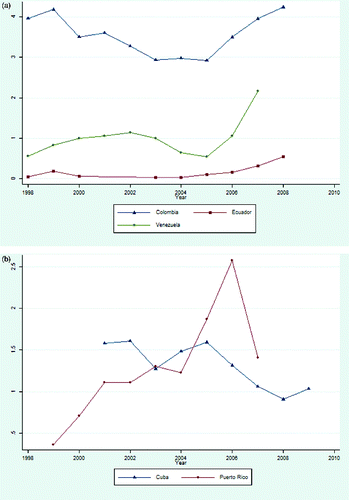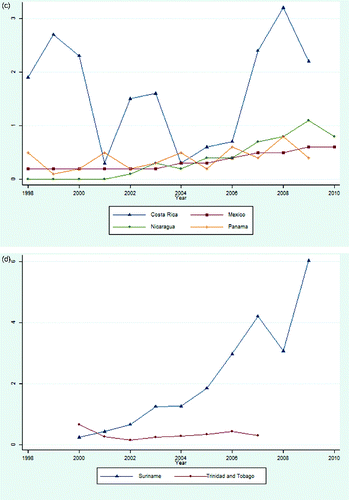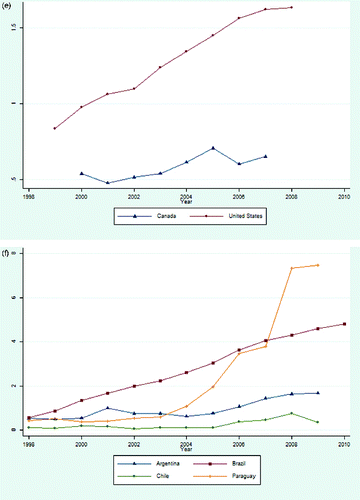Abstract
Injuries, disabilities and deaths among motorcyclists have been rising worldwide but what is happening in the American Continent is not completely known. Deaths from motorcycle crashes of the Pan American Health Organization database (PAHO/WHO, 1998–2010) were included in an ecologic multi-national study to quantify the temporal trends and to estimate the association between motorcycle riders’ deaths and selected socio-economic indicators. Mortality rates increased in all sub-regions. The highest increase was reported in the countries of the Andean sub-region (Ecuador, 78.3%) and Mesoamerica (Costa Rica, 60.0%). Poorer countries fared worse in terms of motorcycle mortality relative to richer countries, as did more unequal ones. Recent economic changes, rapid increment of motorisation rates, affordability of motorcycles over public transportation, lack of adequate public transportation policies and other insufficient measures aimed at improving safety can explain these trends.
Introduction
In the last two decades, injuries, disability and deaths among motorcycle users have been rising worldwide disproportionally affecting young males (Franco Arias, Citation2010a; Instituto de Pesquisa Econômica Aplicada, Citation2006; Zentner, Dellinger, Adkins, & Greene, Citation1995). Motorcycle riders are especially vulnerable to injuries because of the high speeds they can acquire, coupled with small vehicular structures that offer poor protection and are more difficult to be seen in traffic. Consequently riders involved in crashes are more likely to die or be severely injured due to high frequency of head, chest and leg injuries (Peden et al., Citation2004).
In the Americas and the Caribbean, the number of registered vehicles has been estimated at over 387 million of which approximately 24 and a half million are motorcycles. Motorisation rates vary from country to country from 55 per 1000 in Peru to 779 per 1000 in the United States as well as difference of the type of vehicles is observed (Pan American Health Organization, Citation2009). There are also several sub-regional variations.
In this region, traffic-related injuries are the number one cause of death among children aged 5 to 14 years and the second cause among those aged 15 to 44 years. In 2007, 142,252 traffic-related deaths occurred in this region and an estimated 5 million people were injured (Pan American Health Organization, Citation2009). The standardised road traffic mortality rate in the region is 15.8 per 100,000 population with great disparity among countries, ranging from 4.3 per 100,000 in Uruguay to 21.8 per 100,000 in Venezuela. Motorcyclists accounted for 12% of all traffic-related fatalities. The percentage among sub-regions varies from 14% in the Southern Cone to 6% in Mesoamerica. Since the late nineties, fatal and non-fatal motorcycle injuries have been rising in several countries with the consequent economic and social costs associated, hence increasing the public health burden in the region (Pan American Health Organization, Citation2009). A study from the United States documented that motorcyclists incurred higher costs with respect to injury incidence. In 2000, motorcyclists accounted for 6% of fatal and non-fatal injuries, but 12% of the costs, totalling approximately $12 billion of the $99 billion total cost of motorcycle fatalities and injuries (Naumann, Dellinger, Zaloshnja, Lawrence, & Miller, Citation2010).
Young adult males are the main users of motorcycles in Latin America. As a consequence, they account for the largest proportion of motorcycle deaths and injuries. Injuries among these young populations further increase the public health burden in the region through longer periods of rehabilitation, disability and economic losses. The Latin American population is relatively young and about 28% of Latin Americans are under 15 years of age (Franco Arias, Citation2010b). Considering that young adults are mostly at risk for being involved in motorcycle crashes, motorcycle safety constitutes an even greater priority for the region (Hazen & Ehiri, Citation2006).
While many studies have looked at motorcycle injuries trends in the US and Canada (Beck, Dellinger, & O’Neil, Citation2007; Watson, Zador, & Wilks, Citation1980), evaluated policies (Hertz, Citation1989; Hijar, Perez-Nunez, Inclan-Valadez, & Silveira-Rodrigues, Citation2012; Villaveces et al., Citation2003), and looked at economic consequences of motorcycle injuries in those countries (Muelleman, Mlinek, & Collicott, Citation1992; National Highway Traffic Safety Administration, Citation2011), very few have focused on motorcycle morbidity and mortality in the rest of the Americas. A couple of studies from Brazil have documented increases in motorcycle injuries at a national level (Chandran, Sousa, Guo, Bishai, & Pechansky, Citation2012; Instituto de Pesquisa Econômica Aplicada, Citation2006) or described motorcycle injuries in more detail in Sao Paulo state (Gawryszewski et al., Citation2009; Silva, Cardoso, & Santos, 2011). Another study from Cali, Colombia documented increases in motorcycle mortality and estimated changes associated to the implementation of a helmet law (Espitia-Hardeman, V et al., 2008), and one from Jamaica documented associated morbidity and mortality among people seen at a large hospital (Crandon, Harding, Cawich, McDonald, & Fearron-Boothe, Citation2009).
The dearth of information about motorcycle mortality in the Americas highlights the need to document overall regional trends. This study addresses the magnitude of the problem at a regional level, by sub-regions, and by comparing countries with similar economic indicators to highlight the seriousness of the problem, and to raise hypotheses that could explain this phenomenon.
Materials and methods
To investigate the mortality risk throughout the time of a motorcycle rider injured in a transport crash in the American Continent, we undertook an ecologic comparison – trend study among Member Countries of the Pan American Health Organization, the regional office of the World Health Organization in the Americas (PAHO/WHO). We initially considered 48 countries with an approximate total population of 930 million in 2009. Countries were included in the final analysis if they complied with the following conditions: (a) they had data for at least 7 years of the 13-year study period, (b) they had a minimum population of 400 thousand inhabitants and (c) if they had a medium to good data quality index as assessed in 2008 by common PAHO health indicators for the Americas (Pan American Health Organization, 2008). Our final selection of countries yielded 17 nations for the overall regional comparison. Puerto Rico has been considered as a nation although it is an unincorporated territory of the United States of America. The sub-regional comparison (second level of inference), included country groupings according to commonly used PAHO categories: North America (United States of America and Canada); Mesoamerica (Costa Rica, Mexico, Nicaragua, Panama); Latin Caribbean (Cuba, Puerto Rico); Andean (Colombia, Ecuador, Venezuela); Southern Cone (Argentina, Brazil, Chile, Paraguay); and Non-Latin Caribbean (Suriname, Trinidad & Tobago).
Mortality data were drawn from the Regional Database on Mortality compiled by PAHO's Health Analysis Unit from 1998 to 2010. The Regional Database on Mortality compiles information from the national death registries of all Member Governments provided on an annual basis. Deaths from motorcycle riders injured in transport crashes were classified according to the International Classification of Diseases, 10th revision (ICD – 10) under codes V20 – V29 “Motorcycle rider injured in transport crash”.
Data analysis included descriptive statistics by country, sub-region and region. Crude mortality rates were calculated using as the numerator the number of deaths in motorcycle crashes and as denominator the annual mid-period population by age and sex, provided by the United Nations, Population Division for the study period. For between country and between sub-regions comparisons we used age-adjusted mortality rates, using as standard population the WHO world population age-structure constructed for the period 2000–2025. The use of an average world population, as well as a time series of observations, removes the effects of historical events such as wars and famine on population age composition (Ahmad, Boschi-Pinto C, Murray, Lozano, & Inoue, Citation2001).
Using negative binomial models we explored independently the bivariate association between motorcycle mortality and sub-region, sex and age group respectively. We also considered the association of socio-economic indicators and motorcycle deaths using these models. Our exposure variables for this latter model included Gross National Income (GNI) converted to international dollars using purchasing power parity rates and the Highest 20%/Lowest 20% income ratio (H20%/L20%). The median value of H20%/L20% was computed to generate two groups of countries: one with the highest indicator values (meaning lower income sharing) and lower values (higher income sharing). We included only bivariate models due to the number of countries being small and some of these variables are collinear.
Table 1. Motorcycle-related mortality, rates per 100,000 pop and average percent variation (APV), Americas, 1998–2010
Table 2. Mortality rate ratios (and 95% confidence intervals) among motorcyclists in the Americas
Table 3. Age-adjusted motorcycle mortality rates per 100,000 pop by income and shared income among countries with available information for these variables (2000–2010)
Results
In the Americas, the overall motorcycle-related mortality rate was 1.6 per 100,000 in the period 1998–2010. These rates have been increasing very fast, varying from 0.8 per 100,000 in 1998 to 3.5 per 100,000 in 2010. The trend analysis showed that the average percentage variation (APV) from 1998 to 2010 was 12.9% overall. Although the highest rates in the Americas were found in the Southern Cone (2.5 per 100,000) and Andean Area sub-regions (2.3 per 100,000), the highest increase was reported in the countries of the Andean sub-region (Ecuador, 78.3%) and Mesoamerica (Costa Rica, 60.0%).
Countries with the highest mortality rates were Colombia (3.6 per 100,000), Brazil (2.9 per 100,000), Paraguay (2.5 per 100,000) and Suriname (2.2 per 100,000). On the other hand, Chile and Ecuador (0.2 per 100,000) had the lowest mortality rates. However, the countries with the greatest increases in rates in the Southern Cone were Chile and Paraguay. Table summarises the current situation on mortality deaths and rates as well as the APV by sub-regions and countries within them. Our rates are different from the ones reported in the WHO Global Status Report (World Health Organization, Citation2009) because the latter report only computed rates for one year unlike ours that includes the whole period 1998–2010.
In all the Americas, overall the relative risk (RR) of dying for men was 7.8 times greater than for women (95% CI [6.0, 10.2]). Among males, rates varied from 1.4 per 100,000 in 1998 to 6.0 per 100,000 in 2010. Figure shows mortality rate trends from motorcycle crashes by sex and for the overall.
Figure 1. Motorcycle-related mortality by sex, Americas rate per 100,000. Source: Pan American Health Organization, Health Information and Analysis, Mortality database May, 2012.
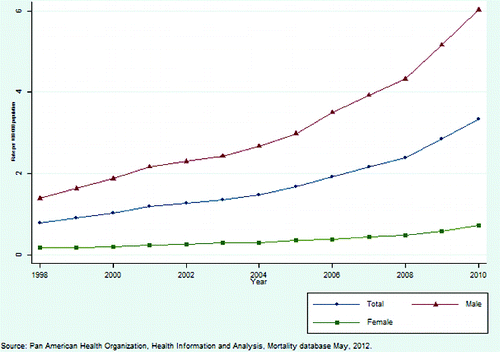
The age groups 15 to 24 and 25 to 34 had the highest risk of dying from motorcycles over the whole study period and region, and among those less than 15 years of age is the one with the lowest rate. Notably, those aged 15 to 24 had a risk 24.3 times higher than those less than 15 years (95% CI [18.1, 32.6]). Figure presents the trends of mortality rates by age groups, where one can see that all the age groups had increasing rates.
Figure 2. Motorcycle-related mortality by age group, Americas rate per 100,000. Source: Pan American Health Organization, Health Information and Analysis, Mortality database May, 2012.
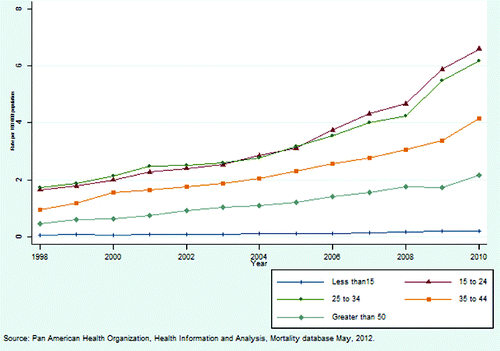
Table shows the estimated rate ratio, confidence intervals and p-values by sub-region, sex and age (Mesoamerica, Female and less than 15 years old serve as the reference, as they have the lowest mortality rates). Motorcycle-related mortality rate ratios by region were greater in the Southern Cone followed by the Andean region, were more common among males, and occurred most commonly among riders aged 25–34 years. Figure shows the trends of motorcycles age-adjusted mortality rates for the countries within each sub-region. Over this period, Colombia had higher rates than Venezuela and Ecuador in the Andean Region, Cuba had decreasing rates in the Latin Caribbean and Costa Rica showed higher rates than Mexico, Nicaragua and Panama in the Mesoamerican sub-region. Suriname had greater rates than Trinidad and Tobago in the Non-Latin Caribbean, the USA reports greater rates than Canada, and Brazil had in general greater rates, compared to Argentina, Chile and Paraguay in the Southern Cone.
Figure 3. Age-adjusted motorcycle mortality trends by sub-region per 100,000. (a) Andean Region, (b) Latin Caribbean, (c) Mesoamerica, (d) Non-Latin Caribbean, (e) North America, (f) Southern Cone.
Motorcycle crash mortality rates are unevenly distributed throughout the Americas. Part of the explanation might be related to differentials in socio-economic characteristics. We also explored this by assessing the relation between poverty (gross national income – GNI converted to international dollars using purchasing power parity rates) as well as how income is distributed across the population: how income is shared between the 20% richest versus the 20% poorest families of a country. Table shows that income distribution seems to be more associated to mortality rates than income levels: countries with better income distribution tend to have lower age-adjusted mortality rates, with a mean mortality rate 2.3 times higher among the poorest. Table shows the association between motorcycle-related mortality and selected socio-economic indicators. Results suggest that countries that are poorer tend to have greater rates of motorcycle fatalities as well as countries that have more inequalities as measured by the percentage of share of income by the highest and lowest 20% of the population.
Table 4. Association of mortality rate ratios and 95% confidence intervals among motorcyclists in relation to selected socio-economic indicators
Discussion
To the best of our knowledge, this is the first paper to show the overall status of motorcycle fatalities over a period of time for the entire region of the Americas. In this region overall, motorcycle-related fatalities have been steadily increasing in the last few years. Despite this, there are important differences in magnitude between countries with some having alarmingly high rates such as Paraguay, Brazil and Colombia, while others despite lower rates, show marked increases in fatalities. For the majority of countries in this region, patterns of mortality are similar to those reported in other studies or from other parts of the globe. Young males are the most affected and most deaths occur in urban settings (Agnihotri & Joshi, Citation2006; Chi & Wang, Citation2007).
Our analysis has some limitations. First, it relies on country-reported information and many countries have different systems. Mortality rates may be underestimated due to data quality problems such as the proportion of deaths that have not been registered, and the proportion of injuries-related deaths of unknown intention.
Our data are country-based and consequently miss any detailed information within country that might provide additional clues about where motorcycle fatalities are higher or lower. We used a series of economic indicators as proxies for social conditions in the country that might be modulating changes in motorcycle fatalities. At an ecological level for example, we found that measures of low income distribution or higher inequalities were related to mortality rates, more than income levels per capita: countries with better income sharing had the lowest mortality rates. Finally, we could not include information from all countries, as some of the data coming from some nations is non-existent or not reliable enough to extrapolate to the entire country. Despite these shortcomings, we believe this study shows differences within the region of the Americas as well as important economic differences related to motorcycle mortality and overall trends of motorcycle-related deaths in several countries of this region.
While the economic situation in several richer countries has been stagnant in the last five years, Latin America has experienced during the same period economic growth that has contributed to an overall reduction in poverty indexes and an increase in wealth (World Bank Group, Citation2011). These improvements however, have not been equal among different nations and some have fared better than others.
Parallel to these economic changes, increases in motorcycle fatalities have also been greater in Latin America relative to North America. One consequence of economic growth is increased motorisation. With increased wealth and reduced poverty, there is evidence that populations experience shifts in modes of transportation as they acquire more means to purchase certain products (Chi & Wang, Citation2007). As countries become motorised and populations acquire more economic means, a percentage of the population shifts from pedestrians and bicyclists to motorcyclists, or from motorcyclists to automobile drivers.
In addition, economic growth is associated with increased demands from transport infrastructure, and mobility becomes a basic factor for satisfying economic needs (Chi & Wang, Citation2007). More demand or use of motorcycles and automobiles has increased the pressure on urban infrastructures (E. Vasconcellos, Citation2008). This further complicates mobility issues as more motorcycles are competing for space used by automobiles and potentially further exacerbating risks of injury, and mortality among riders. In Latin America, the rapid growth of cities and urban populations has considerably outpaced the development of urban transport infrastructures and as a consequence mobility in many large cities has been seriously compromised. To address this, many cities have passed legislation aimed at curbing large motor pools mostly by restricting access to urban areas. These strategies include limiting the use of automobiles on selected days based on the license plate registration numbers (E. A. Vasconcellos, Citation2012). Such a strategy initially used in Mexico City though for controlling air pollution, is now widely spread through the region to address mobility. However, in countries like Colombia, some of these measures do not apply to motorcycle riders. In this country, to circumvent these measures, people have either opted to buy another vehicle, which they use when the other one has restrictions, or buy motorcycles, for which mobility restriction legislation does not apply. A result of this is that populations with lesser resources are buying motorcycles for the first time (da Fonseca Holz & Lindau, Citation2009; E. A. Vasconcellos, Citation2012), and individuals with more resources are also buying these and other vehicles to circumvent mobility restrictions. Added to this, are the increasing costs of public transportation that hinder access to work for populations with the least socio-economic resources (de Ávila Gomide, Citation2004).
In cities with large levels of congestion, motorcycles are used in delivery services, as mototaxis, and for motofreight (Silva et al., Citation2011). Groups working in delivery services in Brazil are known as motoboys who traditionally work under time pressure, and in poor and unsafe conditions leading to a large increase in motorcycle crashes (E. Vasconcellos, Citation2008). Mototaxi service offer has also increased and in Brazil legislation was passed to regulate this service almost a decade ago (Barros Lorenzetti, Citation2003). Data from this country shows that mototaxis are now offered in 90% of the country's towns and 50% of the major cities (Instituto Brasileiro de Geografia e Estatistica, Citation2009). Motorcycle types and types of users might also have different risks. This is an area of study that will require further research in Latin America especially because it can have direct implications among certain occupations or in some regions.
Research has shown that excessive automobile dependence can reduce economic productivity, and policy reforms that improve mobility management by reducing per capita vehicle travel can increase transport system efficiency (Litman, Citation2010). Motorcycles seem to have some advantages for urban mobility because of their size however they are perhaps the most dangerous type of motor vehicle because of their inherent lack of protection for users.
While this study provides no evidence that these economic issues are in fact driving such increases, it shows the important increase of mortality risk in the region of the Americas among motorcycle riders in a short period of time and calls for much-needed research on the human, public health, transportation and social-economic costs associated with motorcycle injuries. The PAHO Plan of Action on Road Safety (Pan American Health Organization, Citation2011) and the Road Safety Decade of Action (World Health Organization, Citation2009) reports highlight relevant interventions that can be considered in order to slow or reverse the increasing trend of motorcycle injury mortality. Examples of such measures could include the development and implementation of motorcycle safety standards regulations.
Implications for safety promotion and public policy
The highlighted socio-economic scenario is further affected by insufficient legislation and enforcement of helmet use. Less than half (40.6%) of the countries in this region have an adequate helmet law implying that helmets should be worn by all passengers of all ages, for all engine types of motorised two wheelers, on all roads, and with helmets required to meet specific safety standards. On a PAHO/WHO generated scale of 0–10 where zero represents no enforcement and 10 is full enforcement, the average regional helmet law enforcement is 5.1/10 while enforcement of speeding laws was reported to be low, with a value of 3.7/10 (Hijar et al., Citation2012).
It is imperative for the region of the Americas to document more clearly what social and economic costs are associated with increased motorcycle-related mortality and morbidity and what are the benefits of managing these modal changes within countries as well as throughout the region. Consequently legislative frameworks will likely need to address issues going beyond helmet use, speed limits and motorcycle driver's licensing procedures to include motorcycle industry responsibilities and occupational safety provisions for workers. Both legislative frameworks as well as infrastructure characteristics need to respond to these challenges so as to reduce morbidity and mortality amongst one of the most productive sectors of population.
References
- Agnihotri, A.K., & Joshi, H.S. (2006). Pattern of road traffic injuries: one year hospital-based study in Western Nepal. International Journal of Injury Control and Safety Promotion, 13(2), 128–130.
- Ahmad, O., Boschi-Pinto C.A., Murray, C., Lozano, R., & Inoue, M. (2001). Age Standardization of Rates: A New WHO Standard. Geneva: World Health Organization.
- Barros Lorenzetti, R.S. (2003). A regulação do serviço de mototáxi. In C. o. Representatives (Ed.), Urban Development, Transit and Transportation. Brasilia: Chamber of Representatives.
- Beck, L.F., Dellinger, A.M., & O’Neil, M.E. (2007). Motor vehicle crash injury rates by mode of travel, United States: using exposure-based methods to quantify differences. American Journal of Epidemiology, 166(2), 212–218.
- Chandran, A., Sousa, T.R., Guo, Y., Bishai, D., & Pechansky, F. (2012). Road traffic deaths in Brazil: rising trends in pedestrian and motorcycle occupant deaths. Traffic Injury Prevention, 13(Suppl 1), 11–16.
- Chi, G. B., & Wang, S.Y. (2007). Study on the secular trend of road traffic injuries and its influencing factors in China. Zhonghua liu xing bing xue za zhi = Zhonghua liuxingbingxue zazhi, 28(2), 148–153.
- Crandon, I.W., Harding, H.E., Cawich, S.O., McDonald, A.H., & Fearron-Boothe, D. (2009). Motorcycle accident injury profiles in Jamaica: an audit from the University Hospital of the West Indies. International Journal of Injury Control and Safety Promotion, 16(3), 175–178.
- da Fonseca Holz, R., & Lindau, L.A. (2009). Panorama internacional do uso e operação de motocicletas. Porto Alegre: Política de Transporte e Inclusão Social 1, (3). Laboratório de Sistemas de Transportes, LASTRAN, Programa de Pós-Graduação em Engenharia de Produção, PPGEP, Universidade Federal do Rio Grande do Sul, UFRGS.
- de Ávila Gomide, A. (2004). Regulação econômica e organização dos serviços de transporte público urbano em cidades brasileiras : Estudos de caso : Relatório final. Brasilia, Ipea: Ministério das Cidades.
- Espitia-Hardeman, V., Velez, L., Munoz, E., Gutierrez-Martinez, M.I., Espinosa-Vallin, R., & Concha-Eastman, A. (2008). [Impact of interventions directed toward motorcyclist death prevention in Cali, Colombia: 1993–2001]. Salud publica de Mexico, 50, Suppl 1, S69–77.
- Franco Arias, C. (2010a). Auditoría en seguridad vial. Ambiente seguro: Intervenciones para prevención de atropellamientos (ASIPA): Estudios viales. Cuernavaca: Instituto Nacional de Salud Publica.
- Franco Arias, C. (2010b). Auditoría en seguridad vial. Ambiente seguro: Intervenciones para prevención de atropellamientos (ASIPA): Problemática y propuestas. Cuernavaca: Instituto Nacional de Salud Publica.
- Gawryszewski, V.P., Coelho, H.M., Scarpelini, S., Zan, R., Jorge, M.H., & Rodrigues, E.M. (2009). [Land transport injuries among emergency department visits in the state of Sao Paulo, in 2005]. Revista de Saude Publica, 43(2), 275–282.
- Hazen, A., & Ehiri, J.E. (2006). Road traffic injuries: Hidden epidemic in less developed countries. Journal of the National Medical Association, 98(1), 73–82.
- Hertz, E.S. (1989). The effect of helmet law repeal on motorcycle fatalities. A four year update. National Highway Traffic Safety Administration. Research Notes, September, 1–4.
- Hijar, M., Perez-Nunez, R., Inclan-Valadez, C., & Silveira-Rodrigues, E.M. (2012). Road safety legislation in the Americas. Revista Panamericana de Salud Publica = Pan American Journal of Public Health, 32(1), 70–76.
- Instituto Brasileiro de Geografia e Estatistica. (2009). Pesquisa sobre oferta de transporte público nos municípios brasileiros. Brasilia: Instituto Brasileiro de Geografia e Estatistica.
- Instituto de Pesquisa Econômica Aplicada. (2006). Impactos sociais e econômicos dos acidentes de trânsito nas rodovias brasileiras. Brasilia: Departamento Nacional de Trânsito.
- Litman, T. (2010). Evaluating transportation economic development impacts. Understanding how transport policy and planning decisions affect employment, incomes, productivity, competitiveness, property values and tax revenues (p. 99). Victoria Transport Policy Institute, August 10. Retrieved from http://www.vtpi.org/econ_dev.pdf
- Muelleman, R.L., Mlinek, E.J., & Collicott, P.E. (1992). Motorcycle crash injuries and costs: Effect of a reenacted comprehensive helmet use law. Annals of Emergency Medicine, 21, 266–272.
- National Highway Traffic Safety Administration. (2011). Determining estimates of lives and costs saved by motorcycle helmets. Washington, DC: U. S. Dept. of Transportation.
- Naumann, R.B., Dellinger, A.M., Zaloshnja, E., Lawrence, B.A., & Miller, T.R. (2010). Incidence and total lifetime costs of motor vehicle-related fatal and nonfatal injury by road user type, United States, 2005. Traffic Injury Prevention, 11(4), 353–360.
- Pan American Health Organization. (2008). Health information and analysis - health situation in the Americas: Basic indicators. Washington, DC: Pan American Health Organization.
- Pan American Health Organization. (2009). Regional status report on road safety in the Americas. Washington, DC: Pan American Health Organization.
- Pan American Health Organization. (2011). Plan of action on road safety. Washington, DC: Pan American Health Organization.
- Peden, M., Scurfield, R., Sleet, D., Mohan, D., Hyder, A.A., Jarawan, E., & Mathers, C. (Eds.). (2004). World Report on Road Traffic Injury Prevention. Geneva: World Health Organization.
- Silva, E.R., Cardoso, B.C., & Santos, M.P.S. (2011). O aumento da taxa de motorização de motocicletas no Brasil. Revista Brasileira de Administração Científica, Aquidabã, 2(2), 50–62.
- Vasconcellos, E. (2008). O custo social da motocicleta no Brasil. Revista dos Transportes Publicos, 119(20), 127–142.
- Vasconcellos, E.A. (2012). Road safety impacts of the motorcycle in Brazil. International Journal of Injury Control and Safety Promotion. doi: 10.1080/17457300.2012.696663.
- Villaveces, A., Cummings, P., Koepsell, T.D., Rivara, F.P., Lumley, T., & Moffat, J. (2003). Association of alcohol-related laws with deaths due to motor vehicle and motorcycle crashes in the United States, 1980–1997. American Journal of Epidemiology, 157(2), 131–140.
- Watson, G.S., Zador, P.L., & Wilks, A. (1980). The repeal of helmet use laws and increased motorcyclist mortality in the United states, 1975–1978. American Journal of Public Health, 70, 579–585.
- World Bank Group. (2011). A Break with history: Fifteen years of inequality reduction in Latin America (pp. 1–29). Washington, DC: World Bank Group.
- World Health Organization. (2009). Global status report on road safety: A time for action. Retrieved from. http://whqlibdoc.who.int/publications/2009/9789241563840_eng.pdf
- Zentner, J., Dellinger, C., Adkins, W.E., & Greene, J. (1995). Nurse practitioner provided primary care: managing health care costs in the workplace. AAOHN Journal; Official Journal of the American Association of Occupational Health Nurses, 43(1), 52–53.

